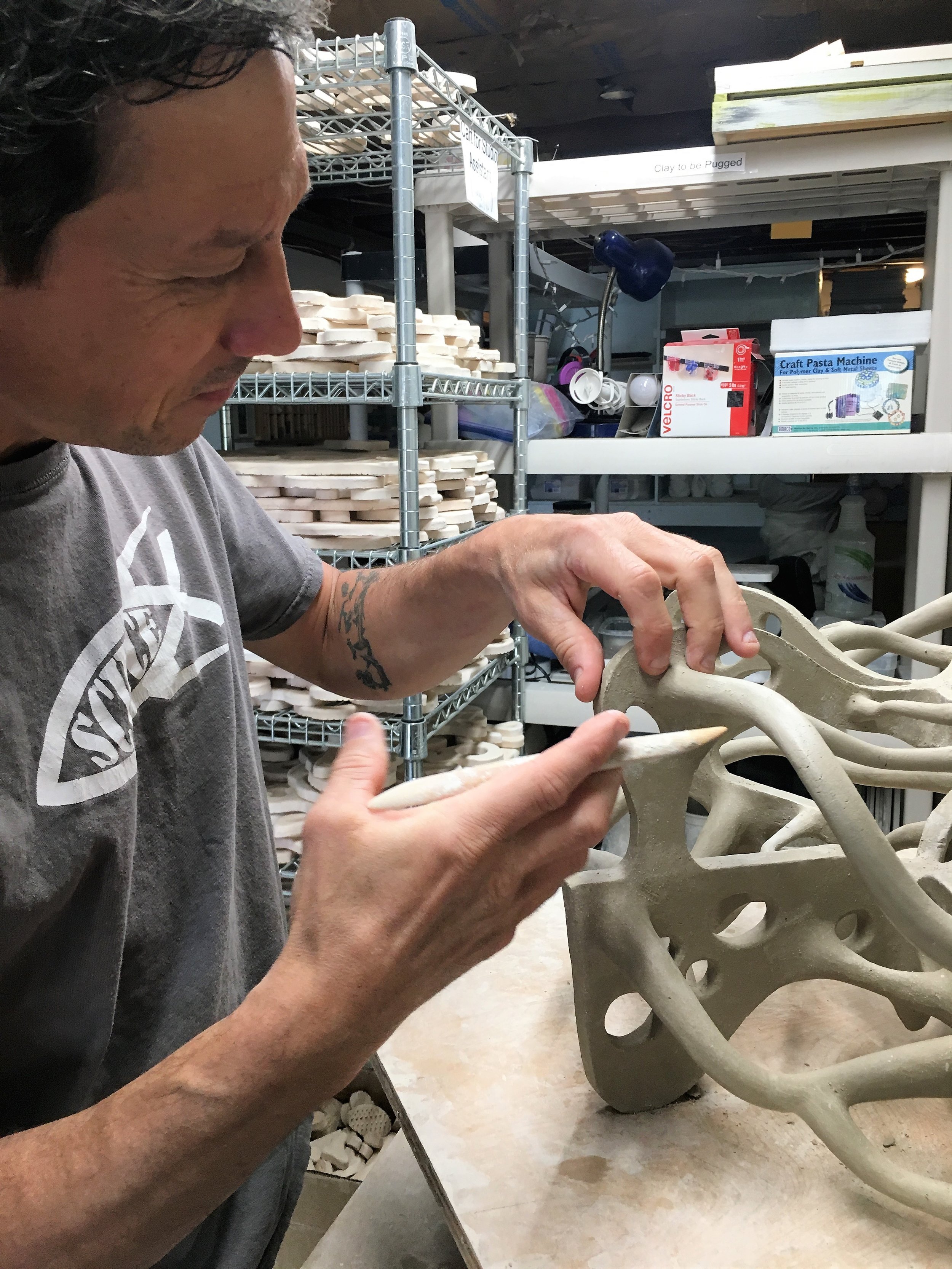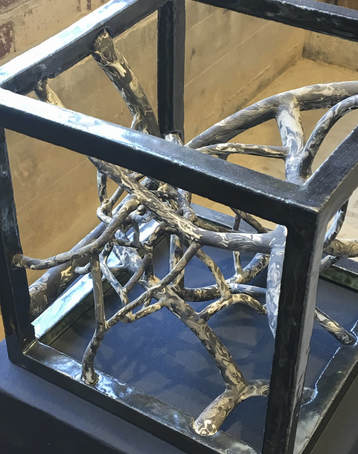Visiting Artist: Joseph Wilkinson
/By: Hayley Reed
Joe Wilkinson is currently a visiting artist at Rat City Studios. He lives in Seattle, Washington where he continues his sculptural ceramic practice. In addition to working in the studio, Joe works as a teacher at Pottery Northwest, and as a fabricator and installer for artist John Grade. Joe explores the themes of negative space, line quality, disruption of pattern, and curiosity in his abstract ceramic sculptures. He received his BFA from the University of Colorado, Boulder and his MFA from Michigan State University.
During his time as a visiting artist at Rat City Studios, Joe has been working on a number of small and large sculptures. Additionally, he has been working on creating unique floor tiles for an enclosed patio space that he and Deborah Schwartzkopf have added onto their home above the studio.
I had the pleasure of interviewing Joe at the Beveridge Place Pub in West Seattle. We talked about his inspirations, process, and the challenges working with clay. Wednesday night is trivia night apparently, but that didn’t stop us from having a good talk and a few beers.
To begin the interview, I asked Joe how he began working with clay. In his artist statement on his website he writes, “His work in clay began in 2008 finding inspiration in the material at the Colorado Mountain College in Breckenridge, Colorado.” I asked him if this had been where he had taken his first clay class, or if it was a return to the material with a new perspective and stronger interest.
Joe Wilkinson working on a sculpture at Rat City Studios
A: Joe responded by saying that he was originally going to start a photo business with two friends prior to starting his work with clay, but it didn’t end up working out. He was looking for a creative outlet, and after browsing the course list for the Colorado Mountain College, he landed on enrolling in a ceramics course. “It just felt like, right away I could do anything that I wanted with clay. It just spoke to me. All the people that were there were really interesting, lovely people that were willing to help me, and we all loved spending time in the studio together. It was such a shift from photo and how isolated that felt.”
Q: That response to working with clay for the first time seems to be very universal. When people first touch clay they love it, and they love the community.
A: Joe spent just over a year at the Colorado Mountain College before returning to Denver. In Denver he joined the art students league where he was inspired by another great arts community with a variety of professors that approached clay in new and unique ways. “I was spending all the time I could in the ceramics studio. I was like, I could do this 24/7 and not feel like I was wasting time, it had purpose to me. It just fed this creative spirit that was really at the forefront of what a life of well being, of purpose really meant.” Later, Joe attended the University of Colorado, Boulder where he received his BFA in Ceramics.
Q: What kind of work were you making then versus now? Or is it pretty similar?
A: “Well there has been one consistency that has always been there from the start, which is long, curved lines. The flow of the pieces has always been there. Another thing that has always been there is negative space, so always holes through things. That's always intrigued me. How do you bridge around space? Like how a handle comes off of a cup. The handle is cool to me, but the negative space that it creates is even more interesting.”
Q: What is it about negative space that intrigues you so much?
A: This intrigue occurs in response to an inundation of objects constantly in our way, fighting for attention. “There is something really lovely about seeing through a break in that. Especially when it's a refined beautiful contour. That is really exciting - it’s just that intriguing stopping point within an overall thing that otherwise is just always a barrier or a solid mass. You're looking through this object and you get to see through, channel in, and it focuses your attention through it on something behind and it creates this little interesting spot.”
Q: You say in your artist statement that your pieces celebrate a state of flux, an interruption of pattern, and the resulting chaos and uncomfortable state of uncertainty. Is this flux and breaking away from pattern something you try to embrace in daily life?
A: “I feel like just being an artist, just even pursuing a career in the arts, is interrupting the status quo. A lot of people and a lot of scholars believe that the act of art is an act of rebellion, and good art is actually based on observing larger trends within the culture and having something to say about it, things that you wish would be changed. I like to think that I'm working towards that. We all are pattern seeking creatures, and so I try not following any particular pattern within my work. I create structures that are very intuitive, almost like drawing with clay, celebrating that state of pattern disassembly with nothing really having an exact pattern recognition to it.” Joe hopes to engage his audience and spark conversations about his work by embracing a lack of structure. “Anything alien is planting a seed of new curiosity, discovery, and I try to promote those senses.”
Q: How do you approach your wall sculptures versus the free standing ones?
A: They're all just really line drawings to me. The space that I'm going to inhabit with these is a little bit more determined - with the wall sculptures. The ones that I've done have all been based on particular wall scales that I want to inhabit, so what are the parameters that I think are going to build the most interesting space within the determined parameters of the gallery. Curating the space as opposed to the free standing sculptures which are more just like a line drawing that I can situate really anywhere, free standing within a gallery space. I have done other works where I’m thinking directly about a person's home or where they might end up on someone’s mantle. So what kind of sculpture can fit there to be interesting within that space.
Q: Do you have a specific glaze in mind when you're creating a piece, or does that come after?
A: Glazing has always been a hard thing for me. I do like the more matte glazes because a lot of my work is about form and it really holds the light nicely.
Q: What is the firing environment for your work?
A: All electric, oxidation in general. I don't mind firing in a gas kiln if it's a big piece. I have been firing recently to cone 6. I think I'll probably go back to low fire. I do like the idea of some of my pieces being able to be outside during the winters, if it's inevitably going to be outside, you don't need to go high fire. Ideally I like to just set the kiln and go.
Q: What do you find most challenging about working with clay?
A: Glazing. And weight. I like to do installation work and you always have to be aware of how much weight you're either putting on the wall or you're going to have to suspend.
Q: What is it about glazing that you find challenging?
A: I've re-fired something 4 or 5 times to finally get a finish that was interesting and unique to that piece and spoke to that piece. I'm making pieces that are very intricate. How do you glaze all of it without brush strokes? And when you spray something it looks sprayed. I want to get it to look more natural, I don't want it to look forced. Truthfully I don't want my pieces to look ceramic. I want them to be ceramic, I love the process, I love the material. But I love it when somebody says 'what is that, what is that made of, that’s ceramic??' It's all about discovery.
Q: What is your favorite tool?
A: It is a very simple tool. It is a straight bamboo tool. It's about 6" long that has a slight curve at the ends. Each side is a different width and it comes to a point so you can really get in and work crevices if you want. It smooths really nicely and pulls clay across seams really beautifully. It feels like a harder substitute for my finger.
Q: Do you use a lot of tools? Some people use a lot of tools some use just a few favorites.
A: I use probably 4 or 5 tools. I love Surforms (rasps), I love two or three different ribs - the Mudtools red and yellow, and paddles.
Q: Have you gotten any advice that has stuck with you over the years about being an artist?
A: Don't get too connected to it. Especially as a ceramic artist because there's going to be things that go wrong during the making process. And, a request to become more articulate about my work. This was a profound statement from Scott Chamberlin at CU Boulder, who I would say is the father figure of my artistic development. He told me that I have an amazing imagination, he just wishes I was more articulate. And that just stuck with me. And I continue to work on that.
Q: How is the tile project going?
A: It's going well. I've finished making tiles which is awesome because they took a long time. We have to pick out grout color now, which is setting a background color. Then after that I am going to collaborate with Deb on what the color and texture of the tiles will be.
Q: Are there any artists that inspire you, clay or otherwise?
A: Number one to me is Olafur Eliasson. He does installation work that is all about natural phenomenons. He uses a ton of light within his work but he is ever about engaging the public in the idea of reconnecting with nature, discovery, curiosity and linking people to scientific ideas.










